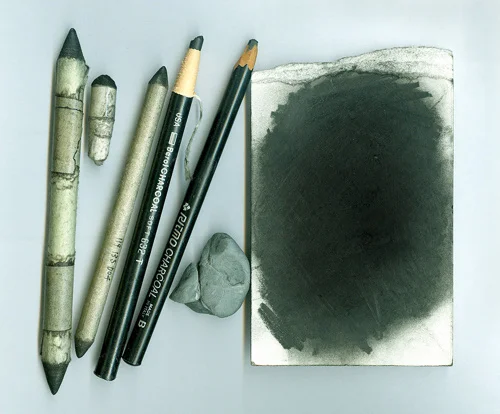THE MOST COMMON QUESTION I HEAR: "WHAT TYPE OF CHARCOAL DO YOU USE?"
An oily charcoal. Vine and less compacted types are too messy and not nearly black enough. Most of my work is done using Berol / soft #632. If you are lucky enough to find it (they went out of business many years ago), it provides a rich deep black. A good substitute are "Ritmo" pencils from Italy -- very smooth and consistent.
PAPER AND ERASER
300 lb cold-pressed cotton -- "Lanaquarelle" from France has a nice tooth and a subtle off-white tone. It stands up well to friction when layering charcoal and pulling highlights with an eraser (Kneaded Eraser by Design).
FIXATIVE
Rarely use it unless I want to flatten the work and darken my mid-tones.
TORTILLON
I've made all kinds of these myself or you can find some wonderful variations of this (typically Italian-made) blending tool. They are lead-less / wood-less pencils of tightly wound paper with a point at one or both ends. How tightly they are wound produces delicate variations likened to the difference one finds in hard vs. soft brushes.
PALETTE
A hand-sized scrap of cardboard-weight (140 to 300lb) cotton paper scribbled thick with charcoal makes a perfect palette. I usually use scraps of left-over trimmings from my work. Regular paper disintegrates.
TECHNIQUE
Charcoals drawn directly onto your surface will permanently "stain" cotton fibers. For that reason, direct pencil-to-surface charcoal is used only for the blackest areas. Mid-tones are created by first stacking thick layers of charcoal onto a "palette." Then, using the tortillon (like paint on a brush), lift and paint charcoal particles onto the fine hairs of the cotton fiber. This method of blending creates tones that are easy to lift out or highlight with the point of a kneaded eraser.
In addition to multiple sizes and densities of tortillons -- compacted balls of bread, felt, chamois cloth or an old-fashioned school eraser make good blending tools. Each material produces a slightly different effect. These tools create blended edges rather than hard lines. Charcoal can be painted rather than drawn.

